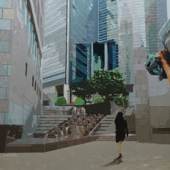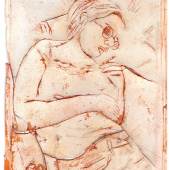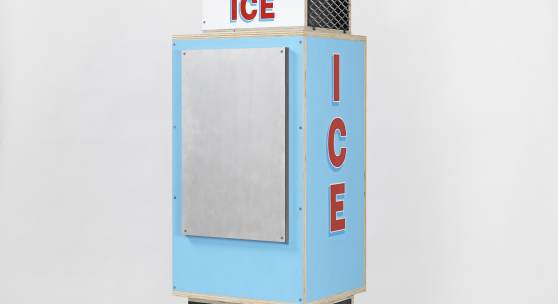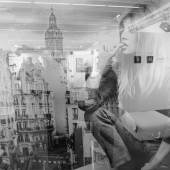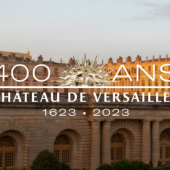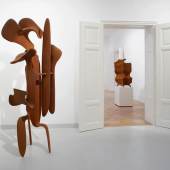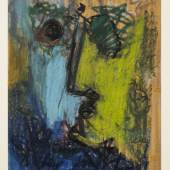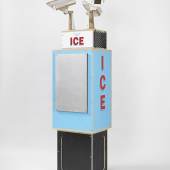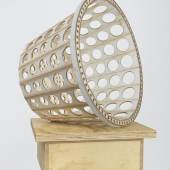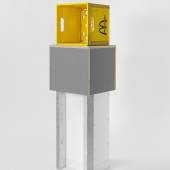Tom Sachs "Ritual"
-
Ausstellung20.01.2021 - 20.02.2021
Thaddaeus Ropac is pleased to present an exhibition of new sculptures by Tom Sachs. On display in the main space of the Paris Marais gallery, Ritual features a selection of new works exhibited on bespoke pedestals inspired by modernist shapes, demonstrating the comprehensive spectrum of Sachs’ distinctive sculptural practice. Each sculpture is characterised by the same bricolage aesthetic that has gained Sachs a unique position in the field of contemporary sculpture. Influenced by the subcultures of an urban metropolis like New York, specifically the phenomenon of New York City’s corner stores, known as bodegas due to their roots in the city’s latin american communities of the 1950s, the artist replicates commonplace industrial objects using everyday materials, including plywood, cardboard, resin, tape, and paint. The sculptures bear traces of their making, becoming vehicles for a reflection on the creation of value and human labour.
With Ritual, Sachs reflects on consumerism while dealing with the history of New York City, and American culture at large. Sachs’ artistic drive is powered by what he calls ‘guilty consumerism’; for him, the making of an object is a way of connecting with it, building intimacy. ”As I create, I meditate on it and the lust of acquiring a product is replaced by the love of making it.”
Although most sculptures on view have a direct relationship with aspects of urban culture specific to New York, their formal qualities and the pedestals on which they are exhibited locate them within a more complex art historical narrative. The totem-like ICE (2020) is a quotidian object often found outside of bodegas and corner markets across the city. With three plywood cameras mounted on it, the sculpture becomes a panopticon and introduces the issue of surveillance in urban spaces, like a contemporary ode to Michel Foucault’s Discipline and Punish as illustrated by a stroll in a New York neighborhood. The Bottle Rack (2016) equally belongs to the bodega, but also refers to Duchamp’s Readymades and,more specifically, to the bottle rack once owned by Robert Rauschenberg, an artist whom Sachs identifies with, both for his art of assemblage and his capacity to salvage and transform the mundane into an artistic form.
“In New York City, like ancient Egypt you’ve got cats or you’ve got rats.” The Bodega cat is a ubiquitous character in New York City street life, protecting these businesses from the omnipresent threat of rats. For the exhibition, the artist has built a cat carrier modeled off the one in the 1979 sci-fi movie Alien.
The laundromat is also an essential necessity of city life. Open 24/7, it is often unsupervised and becomes a shelter and community hub for those who have nowhere else to go. Free and easily accessible, they have also provided cheap filming locations for independent filmmakers, forming an integral part of cinematographic subculture. Within this context, the laundry basket holds particular significance.
The “washer woman” is an archetypal trope throughout the annals of art history, reflecting both strength and femininity, labor and sexuality. When handled by Sachs in The Laundress (2015), the laundry basket becomes an exploration of the grey area between the public and private, reflecting the juxtaposition of performing the mundane yet intimate rituals of daily life in a public space so intrinsic to the cultural landscape of the city.
The laundry basket itself was created utilizing an aerospace process, called lightening, developed by NASA to optimise the weight of an object while simultaneously increasing its strength. Applying this advanced process to an ordinary object invites further reflection on the tenuous relationship between the public and the private; the intersection of innovation and human industry with the intimacy of domestic life.
Placed on a pedestal, formally lifted from Brancusi’s studio, the lowly laundry basket is elevated to the position of high art. Sachs first encountered the work of Constantin Brancusi during his formative years at Bennington College, learning about the pioneering sculptor outside the confines of formal art history classes and developing a personal relationship with Brancusi’s work through library research and trips to New York City, Philadelphia, as well as endless trips to his atelier in the Marais.
While some sculptures in the exhibition might directly evoke the shape of Brancusi’s most famous works such as The Bird in Space or The Kiss, Sachs’ relation to the artist is more connected to the way Brancusi challenged the traditional distinction between the sculpture and the base. Many art historians have noted Brancusi’s passionate concern for the relationship between his sculptures and the space around them and demonstrated how the distinction between the sculptures, the works commonly referred to as their bases, and the other objects in Brancusi’s studio became even more blurred from 1915 onwards. This blur, which corresponds to a questioning of the parameters of sculpture, certainly informed Sachs’ own ambiguous relation to sculpture-as-object and object-as-sculpture.
-
16.01.2020 - 19.01.2020Die Specials und Sonderschau der 24. ART Innsbruck, die Mittwochabend in der Innsbrucker...
-
21.03.2024 - 11.05.2024Die Ausstellung präsentiert neue Arbeiten von Tony Cragg. Die Skulpturen des britischen...
-
21.03.2024 - 11.05.2024Die Ausstellung präsentiert eine Serie von Zeichnungen und Keramikarbeiten des israelischen...
-
20.01.2021 - 20.02.2021
Opening Paris Marais
Wednesday 20 January 2021, 3pm—8pm
On view 20 January—20 February 2021Online exhibition and e-shop to follow
Paris Marais
7, rue Debelleyme
75003 Paris
